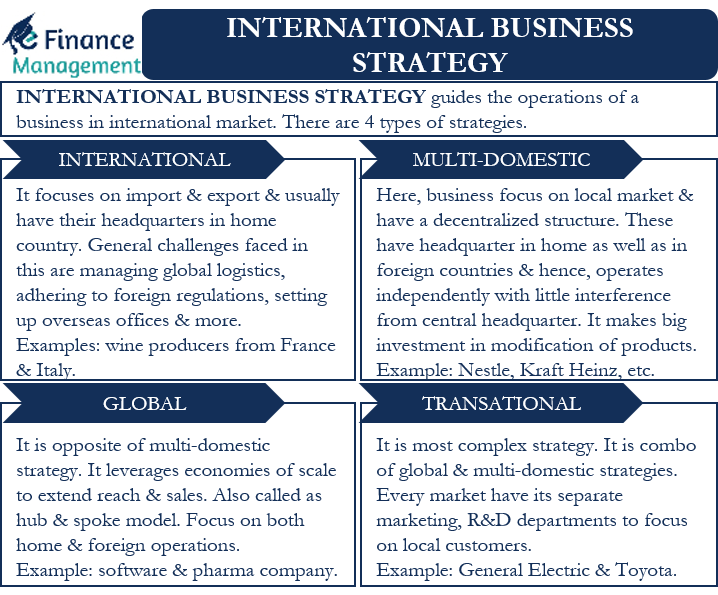International Business Strategy refers to the plans that guide the actions of a company that sells its products and services outside its home country. It should be noted that it refers to the plan and actions of a private company and not to the government. However, government policies do help in shaping these strategies.
These strategies guide companies in how they approach the market and which segment they need to focus on. They also help a company in pricing and corporate structure. With the right strategy, a company can expand its market, maximize ROI, gain a competitive advantage in the individual market and improve its brand image.
First and foremost, there are four types of International Business Strategy: International, Multi-Domestic, Global, and Transnational. Let us understand each type of International Business Strategy in detail.
International
Such a strategy focuses on exporting or importing goods and services to or from abroad. Companies that apply such a strategy usually have their headquarters in their home country. This allows them to save expenditure on personnel and facilities abroad. Small local companies generally use this strategy to deliver goods and services to larger companies in neighboring markets. We also call this strategy an exporting strategy.
However, this strategy faces the usual international business challenges. These challenges include managing global logistics, complying with foreign regulations, establishing offices abroad, and much more. Despite these challenges, it is the most popular strategy among companies because it requires less investment, better control over production and distribution, fewer regulatory issues in a foreign country, etc.
Wine producers from France and Italy are good examples of companies pursuing such a strategy.
Multi-domestic
As part of this strategy, a company must invest in adapting its products or services to local markets. Also, these companies use marketing strategies to position their product in a way that reflects the local community and traditions. Such firms have a decentralized structure.
These companies also have their headquarters in their home country, but their subsidiaries are also headquartered abroad. In addition, these companies set up sales offices, production facilities, or warehouses in foreign markets. Global subsidiaries operate relatively independently and without interference from the central headquarter.
Such a strategy involves some financial risk, as companies make large investments in adapting their products and services to local needs.
Most food and beverage companies have such a strategy. Nestlé is a good example of a company that applies such a strategy, which adapts its product to the local tastes of consumers. Kraft Heinz also uses such a strategy. It adapts its ketchup to the taste of users in the market it operates. MTV is also an example of this strategy, as it adapts its programs to the country in which it operates. There are various other examples of multi-domestic strategy. To know more about it, refer to advantages and disadvantages of multidomestic strategy.

Global
It is the opposite of a multi-domestic strategy. Companies pursuing such a strategy use economies of scale to increase their reach and revenue. To reduce its costs, a company strives to standardize its product or service. Although a company standardizes its product or service, they make a few adjustments to make its product or service fit for the local market.
Structurally, these companies have a central headquarters, usually located in their home country. In addition, they also set up operations in foreign countries as well. Such a structure is known as the hub-and-spoke model, a term commonly used in the logistics and distribution industry.
Software companies are a good example of this strategy. They usually sell a standardized product but may need to change their language. Pharmaceutical companies are also a great example of companies pursuing such a strategy.
Moreover, such a strategy is also effective for companies whose products or services remain hidden from consumers. Intel chips and Qualcomm processor chips are some good examples of this structure.
Transnational
It is the most complex international business strategy. We can say that it is a combination of global and multi-domestic strategies. The aim of this strategy is to help companies maximize local responsiveness, increase local presence and add a local aspect, as well as benefit from global integration.
Generally, a company that applies this strategy keeps its headquarters and core technologies in its home country. But, such companies are also massively active abroad.
These operations in foreign markets are given full autonomy in deciding on production and distribution. In addition, each market has its own marketing, research, and development departments to focus on local customers. Therefore, such a strategy requires massive investment.
Large companies usually pursue such a strategy because of the enormous investment needs. General Electric and Toyota are good examples of companies pursuing such a strategy, having made massive investments in building up research, manufacturing, and marketing departments in the countries in which they operate. Unilever is also a good example.
Final Words
In order to select a suitable international business strategy, a company must evaluate its capabilities and the market it plans to enter. Companies that want to focus their business internationally can also choose one or more of these strategies. Thus, for example, a company can start with an international strategy. However, according to a market assessment, it can switch to a different strategy if it feels that it will achieve better results.
Visit International Business for more details.

